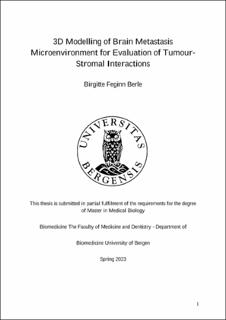| dc.description.abstract | Brain metastases (BM) occur when cancer cells from the primary location spread to the brain through the bloodstream. BM affects approximately 20-40 % of cancer patients, with the majority originating from lung, breast, and skin cancers. If left untreated, the median survival time is usually only one month, and aggressive treatment only extends survival to around four months. Despite the advances in modern medicine, the blood-brain barrier (BBB) poses a significant challenge in treating BM, restricting the entry of approximately 98 % of chemotherapeutic drugs into the brain. Thus, better model systems are needed to understand the complex interplay between cancer cells and normal brain cells. In order to generate novel models, a range of cell lines derived from lung, breast and skin BM were characterized to understand their behaviour in vitro. Subsequently, their distinguishing features were analyzed to identify the most suitable candidates for generating three-dimensional models, which can later be used for drug testing. We found that LBM1, derived from a lung cancer BM, and H16, developed from a melanoma BM, were the best candidates for spheroid formation. The two cell lines underwent treatment with thioridazine, an antipsychotic drug that has been previously tested by our group on various melanoma BM cell lines and demonstrated a significant reduction in their viability. Comparable results were seen with LBM1 and H16 cells. The potential of LBM1- and H16-derived exosomes to serve as imaging agents was also investigated, with focus on iron oxide labelling using carboxyl-coated superparamagnetic iron oxide nanoparticles (SPIONs), through electroporation. To verify the electroporation, further investigation is necessary to confirm the presence of the iron oxide particles within the exosomes. However, dextran-coated SPIONs were successfully internalised by LBM1 cells following 24 h incubation, suggesting its potential labelling attributes and potential uptake by LBM1-derived exosomes. Lastly, LBM1 and H16 cells were injected intracardially into four non-obese diabetic/severe combined immunodeficient (NOD-SCID) mice each for evaluation of their tumourigenic potential. Despite a small sample size, H16-injected mice demonstrated a 23 % increased survival time compared to LBM1-injected mice, but no tumours were observed at week 4. In contrast, 3 out of 4 LBM1-injected mice displayed brain tumours four weeks following injection, thus demonstrating its potential as a model system for future BM research. | |
